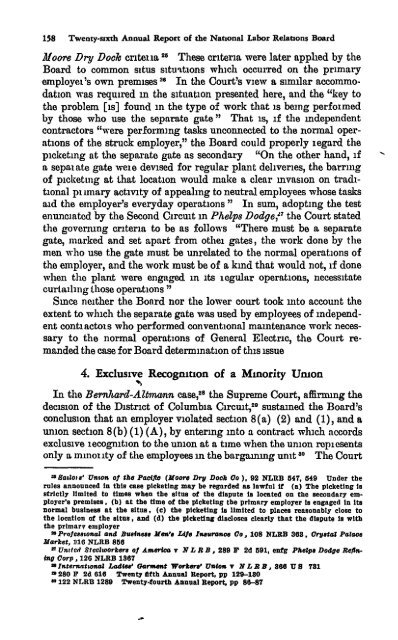TWENTY-SIXTH ANNUAL REPORT - National Labor Relations Board
TWENTY-SIXTH ANNUAL REPORT - National Labor Relations Board
TWENTY-SIXTH ANNUAL REPORT - National Labor Relations Board
Create successful ePaper yourself
Turn your PDF publications into a flip-book with our unique Google optimized e-Paper software.
158 Twenty-sixth Annual Report of the <strong>National</strong> <strong>Labor</strong> <strong>Relations</strong> <strong>Board</strong><br />
Moore Dry Dock critena 25 These criteria were later applied by the<br />
<strong>Board</strong> to common situs situations which occurred on the primary<br />
employees own premises 26 In the Court's view a similar accommodation<br />
was required m the situation presented here, and the "key to<br />
the problem [is] found in the type of work that is being perfoimed<br />
by those who use the separate gate" That is, if the independent<br />
contractors "were performing tasks unconnected to the normal operations<br />
of the struck employer," the <strong>Board</strong> could properly legard the<br />
picketing at the separate gate as secondary "On the other hand, if<br />
a sepal ate gate weie devised for regular plant deliveries, the barring<br />
of picketing at that location would make a clear invasion on traditional<br />
pi nnary activity of appealing to neutral employees whose tasks<br />
aid the employer's everyday operations" In sum, adopting the test<br />
enunciated by the Second Circuit in Phelps Dodge 7 the Court stated<br />
the governing criteria to be as follows "There must be a separate<br />
gate, marked and set apart from othei gates, the work done by the<br />
men who use the gate must be unrelated to the normal operations of<br />
the employer, and the work must be of a kind that would not, if done<br />
when the plant were engaged in its iegular operations, necessitate<br />
curtailing those operations"<br />
Since neither the <strong>Board</strong> nor the lower court took into account the<br />
extent to which the separate gate was used by employees of independent<br />
contiactois who performed conventional maintenance work necessary<br />
to the normal operations of General Electric, the Court remanded<br />
the case for <strong>Board</strong> determination of this issue<br />
4. Exclusive Recognition of a Minority Union<br />
In the Bernhard-Altmann case," the Supreme Court, affirming the<br />
decision of the District of Columbia Circuit," sustained the <strong>Board</strong>'s<br />
conclusion that an employer violated section 8(a) (2) and (1), and a<br />
union section 8(b) (1) (A), by entering into a contract which accords<br />
exclusive iecognition to the union at a time when the union repiesents<br />
only a minoxity of the employees in the bargaining unit 3° The Court<br />
25 Saatme Union of the Pacific (Moore Dry Dock Oo ), 92 NLRB 547,549 Under the<br />
rules announced in this case picketing may be regarded as lawful if (a) The picketing is<br />
strictly limited to times when the situs of the dispute is located on the secondary employer's<br />
premises, (b) at the time of the picketing the primary employer is engaged in its<br />
normal business at the situs , (c) the picketing is limited to places reasonably close to<br />
the location of the situ , and (d) the picketing discloses clearly that the dispute is with<br />
the primary employer<br />
• Projemonal and Business Men's Life Insurance Co, 108 NLRB 303, Crystal Palace<br />
Market, 116 rums 858<br />
• United Steelworkers of America v NLRB, 289 F 2d 591, enfg Phelps Dodge Refining<br />
Corp 0.26 NLRB 1387<br />
International Ladies' Garment Workers' Union v NLRB, 866 US 781<br />
21 280 F 2d 818 Twenty fifth Annual Report, pp 129-130<br />
80 122 NLRB 1289 Twenty-fourth Annual Report, pp 88-87

















